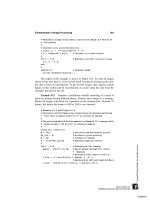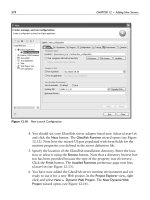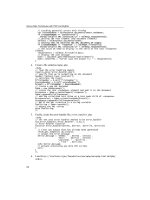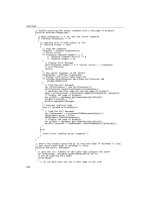Practical PHP and MySQLBuilding Eight Dynamic Web Applications phần 9 pps
Bạn đang xem bản rút gọn của tài liệu. Xem và tải ngay bản đầy đủ của tài liệu tại đây (6.65 MB, 52 trang )
403
CHAPTER 10 Building a Re-Usable Project
break;
case "screenshots":
if(!$_POST) {
include_header();
menu_options();
}
require("project_adminaddscreenshot.php");
break;
Add the delete screenshots block:
break;
case "deletescreenshot":
if(isset($_GET['conf']) == FALSE) {
include_header();
menu_options();
}
require("project_admindeletescreenshot.php");
break;
If no legitimate setting was passed to the func GET variable, the default
block is entered. This code asks the user which project she would like to
administer.
When a user has selected a project, the
SESS_PROJECTID and SESS_PROJECTPATH
session variables are created. These variables track the project in which the user is
interested. First, check to see if
SESS_PROJECTID is already set and a project already
chosen:
break;
default:
if($_SESSION['SESS_PROJECTID']) {
header("Location: " . $config_projectadminbasedir
. basename($SCRIPT_NAME) . "?func=main");
}
If the variable exists, the page simply redirects to the main block. If the variable
does not exist, ask the user to choose a project:
header("Location: " . $config_projectadminbasedir
. basename($SCRIPT_NAME) . "?func=main");
}
else {
include_header();
echo "<h1>Choose a project</h1>";
echo "<p>Which project would you like to administer?</p>";
404
Practical PHP and MySQL
$projsql = "SELECT * FROM homeproject_projects;";
$projresult = mysql_query($projsql);
$projnumrows = mysql_num_rows($projresult);
Here you perform a query to gather the available projects.
Check if any rows were returned:
$projnumrows = mysql_num_rows($projresult);
if($projnumrows == 0) {
echo "<p>No projects!</p>";
}
If no rows are returned, there are no projects on the system. If projects exist,
display them to the user:
echo "<p>No projects!</p>";
}
else {
echo "<ul>";
while($projrow = mysql_fetch_assoc($projresult)) {
echo "<li><a href='" . $SCRIPT_NAME
. "?func=setproject&id=" . $projrow['id'] . "'>" . $projrow['name']
. "</a></li>";
}
echo "</ul>";
}
Each project links to the setproject block and passes the id of project as the
id GET variable.
If the user wants to create a new project, add a link to do so:
echo "</ul>";
}
echo "<a href='" . $SCRIPT_NAME . "?func=newproject'>
Create a new project</a>";
}
break;
}
Add the setproject block:
break;
}
case "setproject":
$pathsql = "SELECT * FROM homeproject_projects WHERE id = "
. $validid . ";";
405
CHAPTER 10 Building a Re-Usable Project
$pathresult = mysql_query($pathsql);
$pathrow = mysql_fetch_assoc($pathresult);
session_register("SESS_PROJECTID");
session_register("SESS_PROJECTPATH");
$_SESSION['SESS_PROJECTID'] = $validid;
$_SESSION['SESS_PROJECTPATH'] = $pathrow['pathname'];
header("Location: " . $config_projectadminbasedir
. basename($SCRIPT_NAME) . "?func=main");
break;
Here a query returns the record from homeprojects_projects, with the id passed
in the
id GET variable. The session variables are then created, and the page redi-
rects to the
main block.
Add the
changeproject block:
break;
case "changeproject":
session_destroy();
header("Location: " . $config_projectadminbasedir
. basename($SCRIPT_NAME));
break;
When the user clicks the Admin Another Project option, the session is destroyed
and the page redirects to allow another project to be chosen.
Finally, add the
main block:
break;
case "main":
include_header();
$projsql = "SELECT * FROM homeproject_projects WHERE id = "
. $_SESSION['SESS_PROJECTID'] . ";";
$projresult = mysql_query($projsql);
$projrow = mysql_fetch_assoc($projresult);
echo "<h1>" . $projrow['name'] . " Administration</h1>";
menu_options();
exit;
break;
This code simply displays the name of the project to be administered.
406
Practical PHP and MySQL
CHANGING GENERAL SETTINGS
Every project in the application includes some simple general settings. These
include the project name, pathname, and description. This page provides a form
with the existing details filled in and then updates the database entry.
Create project_admingeneral.php and add the code shown in Example 10-8.
EXAMPLE 10-8 This page is your common-or-garden form and database
script.
<?php
require_once(" /project_functions.php");
pf_protect_admin_page();
$sql = "SELECT * FROM homeproject_projects WHERE id = "
. $_SESSION['SESS_PROJECTID'] . ";";
$result = mysql_query($sql);
$row = mysql_fetch_assoc($result);
if($_POST['submit']) {
$updsql = "UPDATE homeproject_projects SET"
. " name = '" . pf_fix_slashes($_POST['name']) . "'"
. ", about = '" . pf_fix_slashes($_POST['about']) . "'"
. ", pathname = '" . pf_fix_slashes($_POST['pathname']) . "'"
. " WHERE id =" . $_SESSION['SESS_PROJECTID'] . ";";
mysql_query($updsql);
echo "<h1>Updated</h1>";
echo "Project settings have been updated.";
}
else {
?>
<h1>Project Information</h1>
<form action="<?php echo $SCRIPT_NAME; ?>?func=general"
method="POST">
<table>
<tr>
<td>Project Name</td>
<td><input type="text" name="name" value="<?php echo
$row['name'] ?>"></td>
</tr>
<tr>
<td>Path Name</td>
<td><input type="text" name="pathname" value="<?php echo
$row['pathname'] ?>"></td>
</tr>
<tr>
<td>Description</td>
407
CHAPTER 10 Building a Re-Usable Project
FIGURE 10-6 A simple form makes it possible to change project settings.
<td><textarea name="about" rows="10" cols="50"><?php echo
$row['about'] ?></textarea></td>
</tr>
<tr>
<td></td>
<td><input type="submit" name="submit" value="Modify
details"></td>
</tr>
</table>
</form>
<?php
}
?>
The completed form should look like as shown in Figure 10-6.
MANAGING DOWNLOADS
Possibly the most important feature to administer in a project is the capability to
view the different versions and available downloads. Not only is this an essential
feature, but also it is quite complex because the same pages presents two different
types of functionality (managing versions and managing releases). Before you start
coding the page, step back and identify how the feature should work. This will
make understanding the code easier.
Administering downloads is performed in the interface shown in Figure 10-7.
408
Practical PHP and MySQL
FIGURE 10-8 The version form appears inside the interface.
FIGURE 10-9 Adding releases is as simple as clicking the link and filling in
the form.
FIGURE 10-7 A simple interface allows you to manage ver-
sions and releases in a single page.
Inside the table, you can see the version numbers, releases, and links to add a
new content. Instead of clicking a link and being directed to a different page to add
the version or release, it makes better sense to replace the link with the form. As
such, when you click the Add a New Version link, you see the result shown in Fig-
ure 10-8.
Similarly, when you click the Add a New Release link, you see the result shown
in Figure 10-9.
409
CHAPTER 10 Building a Re-Usable Project
The complexity in the code does not specifically lie in difficult or complex
statements but in lots of nested blocks checking different conditions and respond-
ing accordingly. It is recommended that you add the entire code first and then
reread the instructions of how it works.
Create a new file called project_admindownloads.php and begin adding the
code. Begin by displaying the interface shown in Figure 10-7 (you can process the
forms later):
$versql = "SELECT * FROM homeproject_releaseversions WHERE
project_id = " . $_SESSION['SESS_PROJECTID'] . " ORDER BY id DESC;";
$verresult = mysql_query($versql);
$vernumrows = mysql_num_rows($verresult);
echo "<h1>Manage Downloads</h1>";
You begin by selecting all of the versions associated with the current project.
Open the table and add the first row:
echo "<h1>Manage Downloads</h1>";
echo "<table border=1 cellpadding=5>";
echo "<tr><td colspan=3>";
The first row can contain either the Add a New Version link or the form to add
the version. If the user clicks the link, an
addver GET variable is sent to the page.
As such, check if this variable exists. If it does, display the form; otherwise, display
the link:
echo "<tr><td colspan=3>";
if($_GET['addver']) {
echo "<form action='" . $SCRIPT_NAME . "?func=downloads'
method='POST'>";
echo "<strong>New Release Number: ";
echo "<input type='text' name='version'>";
echo "<input type='submit' value='Add' name='versubmit'>";
echo "</form>";
}
else {
echo "<a href='" . $SCRIPT_NAME . "?func=downloads&addver=1'>
Add a New Version</a>";
}
echo "</td></tr>";
With the first row complete, iterate through the versions. First, check if any ver-
sions were returned from the query:
410
Practical PHP and MySQL
NOTE
Get the Right Submit Button
The Submit button in the form is named
versubmit. This page has two Sub-
mit buttons (one for the version and one for the releases), and you need to
be able to distinguish which one is clicked.
echo "</td></tr>";
if($vernumrows == 0) {
echo "<tr><td colspan=2>This project has no versions
or releases.</td></tr>";
}
If no rows are present, a message indicates that no versions or releases exist. If
rows are presents, display them:
echo "<tr><td colspan=2>This project has no versions
or releases.</td></tr>";
}
else {
while($verrow = mysql_fetch_assoc($verresult)) {
echo "<tr>";
echo "<td><strong>" . $verrow['version']
. "</strong></td>";
echo "<td>";
$relsql = "SELECT homeproject_releasefiles.id,
homeproject_releasefiles.filename, homeproject_releasefiles.date,
homeproject_releasetypes.type FROM homeproject_releaseversions INNER
JOIN homeproject_releasefiles ON homeproject_releasefiles.version_id
= homeproject_releaseversions.id INNER JOIN homeproject_releasetypes
ON homeproject_releasefiles.type_id = homeproject_releasetypes.id
WHERE homeproject_releaseversions.id = " . $verrow['id'];
$relresult = mysql_query($relsql);
$relnumrows = mysql_num_rows($relresult);
In this case, you add the version number in the first cell and then run a query to
gather the releases available for that version. This query returns the
id, filename,
date, and type for each version by performing an inner join to hook together the
homeproject_releaseversions, homeproject_releasefiles, and homeproject_releasetypes
tables.
Check if any releases are returned and display them accordingly:
$relnumrows = mysql_num_rows($relresult);
if($relnumrows == 0) {
411
CHAPTER 10 Building a Re-Usable Project
echo "No releases!";
}
else {
while($relrow = mysql_fetch_assoc($relresult)) {
echo "[<a href='" . $SCRIPT_NAME
. "?func=deleterelease&relid=" . $relrow['id'] . "'>X</a>]
<a href='releases/" . $relrow['filename'] . "'>" . $relrow['type']
. "</a><br>";
}
}
echo "</td>";
Next to each release, an X link is added so that the user can delete a release.
This links to the
deleterelease block and passes the id of the release. (This block
is discussed later.)
In the third cell, either an Add a New Release link or the form is displayed.
When the link is clicked, an
addrelver GET variable is added to the address bar
that is set to the version id. If the version id for the current row is the same as the
value as
addrelver, the link on the current row was clicked. As such, you need to
display the form:
echo "</td>";
echo "<td>";
if($_GET['addrelver'] == $verrow['id']) {
$typessql = "SELECT * FROM homeproject_releasetypes;";
$typesresult = mysql_query($typessql);
echo "<form action='" . $SCRIPT_NAME
. "?func=downloads&ver=" . $verrow['id'] . "' method='POST'
enctype='multipart/form-data'>";
echo "<select name='type'>";
while($typesrow = mysql_fetch_assoc($typesresult)) {
echo "<option value=" . $typesrow['id'] . ">"
. $typesrow['type'] . "</option>";
}
echo "</select>";
echo "<input type='file' name='releasefile'>";
echo "<input type='submit' value='Add'
name='relsubmit'>";
echo "</form>";
}
else {
echo "<a href='" . $SCRIPT_NAME
. "?func=downloads&addrelver=" . $verrow['id']
. "'>Add a New Release</a>";
}
412
Practical PHP and MySQL
When the form is displayed, the select box contains a list of the types from the
homeproject_releasetypes table. The Submit button is called
relsubmit so that you
can determine whether the user clicked the version or release Submit button.
Close the remaining code:
echo "<a href='" . $SCRIPT_NAME
. "?func=downloads&addrelver=" . $verrow['id']
. "'>Add a New Release</a>";
}
echo "</td>";
echo "</tr>";
}
echo "<table>";
}
With the main interface portions complete, you can focus on processing the
form. Jump to the start of the file and begin adding the code:
<?php
require_once(" /project_functions.php");
pf_protect_admin_page();
$uploaddir = $config_projectdir . $_SESSION['SESS_PROJECTPATH']
. "/releases/";
After protecting the page, you set a variable called $uploaddir. This variable
specifies the location where releases are uploaded. You want to upload files to
the releases directory inside the project directory so that you can concatenate the
$config_projectdir and SESS_PROJECTPATH variables and then add the releases
directory.
Begin processing the version form:
$uploaddir = $config_projectdir . $_SESSION['SESS_PROJECTPATH']
. "/releases/";
if($_POST['versubmit']) {
$addsql = "INSERT INTO homeproject_releaseversions(project_id,
version) VALUES("
. $_SESSION['SESS_PROJECTID']
. ", '" . $_POST['version'] . "')";
mysql_query($addsql);
header("Location: " . $config_projectadminbasedir
. basename($SCRIPT_NAME) . "?func=downloads");
}
413
CHAPTER 10 Building a Re-Usable Project
This code runs an INSERT query to add the version to the database. The page
then redirects to the same page, reloading it.
Process the release form:
header("Location: " . $config_projectadminbasedir
. basename($SCRIPT_NAME) . "?func=downloads");
}
elseif($_POST['relsubmit']) {
$uploadfile = $uploaddir . basename($_FILES['releasefile']
['name']);
if(move_uploaded_file($_FILES['releasefile']['tmp_name'],
$uploadfile)) {
$addsql = "INSERT INTO homeproject_releasefiles(type_id, date,
version_id, filename) VALUES("
. $_POST['type']
. ", NOW()"
. ", " . $_GET['ver']
. ", '" . $_FILES['releasefile']['name']
. "')";
mysql_query($addsql);
header("Location: " . $config_projectadminbasedir
. basename($SCRIPT_NAME) . "?func=downloads");
}
else {
echo "Possible file upload attack!\n";
}
To process the form, you need to copy the file to the releases directory and add
the releases to the database. The
$uploadfile variable adds the name of the file to
$uploaddir and then move_uploaded_file() attempts to copy the file from the tem-
porary location to the releases directory. This process works in exactly the same
way as copying image uploads (discussed in the Auction project earlier in this
book).
With the processing complete, add the
else that contains the code to draw the
interface:
echo "Possible file upload attack!\n";
}
}
else {
$versql = "SELECT * FROM homeproject_releaseversions
WHERE project_id = " . $_SESSION['SESS_PROJECTID']
. " ORDER BY id DESC;";
414
Practical PHP and MySQL
Finally, close the form:
echo "<table>";
}
}
?>
DELETING RELEASES
The code for deleting releases is virtually the same as deleting content in other
projects. The only difference is that you also need to remove the file.
Create project_admindeleterelease.php and add the code shown in Example 10-9.
EXAMPLE 10-9 Deleting releases involves removing the file, removing the
database record, and then redirecting.
<?php
require_once(" /project_functions.php");
pf_protect_admin_page();
if(pf_check_number($_GET['relid']) == TRUE) {
$validrelid = $_GET['relid'];
}
else {
header("Location: " . $config_projectadminbasedir);
}
if($_GET['conf']) {
$uploaddir = $config_projectdir . $_SESSION['SESS_PROJECTPATH']
. "/releases/";
$filesql = "SELECT filename FROM homeproject_releasefiles WHERE
id = " . $validrelid . ";";
$fileresult = mysql_query($filesql);
$filerow = mysql_fetch_assoc($fileresult);
$fullfile = $uploaddir . $filerow['filename'];
if(file_exists($fullfile) == TRUE) {
unlink($fullfile);
$delsql = "DELETE FROM homeproject_releasefiles WHERE id = "
. $validrelid . ";";
mysql_query($delsql);
415
CHAPTER 10 Building a Re-Usable Project
NOTE
Check for Permissions
You can improve the current code by adding some error checking to see if
the file can be removed. If there are incorrect permissions, this could cause
a problem, and you might want to put up an error message.
header("Location: " . $config_projectadminbasedir
. basename($SCRIPT_NAME) . "?func=downloads");
}
else {
echo "<h1>File does not exist</h1>";
echo "The file you tried to delete does not exist.";
}
}
else {
echo "<h1>Are you sure you want to delete this release?</h1>";
echo "<p>[<a href='" . $SCRIPT_NAME
. "?func=deleterelease&conf=1&relid="
. $validrelid . "'>Yes</a>] [<a href='"
. $SCRIPT_NAME . "?func=main'>No</a>]";
}
?>
When the file is loaded, the user is asked to confirm that he wants to delete the
release. If he clicks Yes, the page adds the
conf GET variable and links to itself.
When the page is reloaded, a check is made to see if the file exists (using
file_exists()). If the file exists, it removed using unlink(), and the record is
deleted from the database. Finally, the page redirects to the Downloads page.
MANAGING SCREENSHOTS
Managing screenshots works in a similar way to the release management—albeit
with a different interface. Those of you who have worked through the auctions proj-
ect earlier in this book will be pleased to know that the functionality is virtually
identical. As such, when working through the next few pages, you can reference the
auctions code to see how it all fits together.
The interface for adding and deleting images is simple and can be seen in
Figure 10-10.
416
Practical PHP and MySQL
FIGURE 10-10
Adding and removing images is only a
couple of clicks away.
The Browse button can be used to upload an image for the current project, and the
Delete links can be used to blitz the image if no one likes it or if you accidentally
upload pictures of your dog.
Create project_adminaddscreenshot.php and add the form:
<form enctype="multipart/form-data" action="<?php echo $SCRIPT_NAME;
?>?func=screenshots" method="POST">
<table>
<tr>
<td>Image to upload</td>
<td><input name="userfile" type="file"></td>
</tr>
<tr>
<td colspan=2><input type="submit" name="submit" value="Upload
File"></td>
</tr>
</table>
</form>
The form includes the expected browse box and a Submit button. Jump to the
start of the file and protect the page:
<?php
require_once(" /project_functions.php");
pf_protect_admin_page();
Add the form-processing code:
pf_protect_admin_page();
if($_POST['submit']) {
if($_FILES['userfile']['name'] == '') {
header("Location: " . $HOST_NAME . $SCRIPT_NAME
. "?func=screenshots&error=nophoto");
}
elseif($_FILES['userfile']['size'] == 0) {
header("Location: " . $HOST_NAME . $SCRIPT_NAME
. "?func=screenshots&error=photoprob");
417
CHAPTER 10 Building a Re-Usable Project
}
elseif(!getimagesize($_FILES['userfile']['tmp_name'])) {
header("Location: " . $HOST_NAME . $SCRIPT_NAME
. "?func=screenshots&error=invalid");
}
else {
$uploaddir = $config_projectdir . $_SESSION['SESS_PROJECTPATH']
. "/screenshots/";
$uploadfile = $uploaddir . $_FILES['userfile']['name'];
if(move_uploaded_file($_FILES['userfile']['tmp_name'],
$uploadfile)) {
$inssql = "INSERT INTO homeproject_screenshots(project_id,
name) VALUES(" . $_SESSION['SESS_PROJECTID'] . ", '"
. $_FILES['userfile']['name'] . "')";
mysql_query($inssql);
header("Location: " . $HOST_NAME . $SCRIPT_NAME
. "?func=screenshots");
}
else {
echo 'There was a problem uploading your file.<br />';
}
}
}
The code runs the uploaded image through the checks and then copies it to the
upload directory (the screenshots directory in the current project’s path). The page
finally redirects to the same page.
Add the
else, but before you display the form, run a query to display the exist-
ing screenshots:
}
}
}
else {
$imagessql = "SELECT * FROM homeproject_screenshots WHERE project_id
= " . $_SESSION['SESS_PROJECTID'] . ";";
$imagesresult = mysql_query($imagessql);
$imagesnumrows = mysql_num_rows($imagesresult);
echo "<h1>Current images</h1>";
if($imagesnumrows == 0) {
echo "No images.";
}
else {
echo "<table>";
while($imagesrow = mysql_fetch_assoc($imagesresult)) {
echo "<tr>";
echo "<td><img src='" . $config_projecturl .
$_SESSION['SESS_PROJECTPATH'] . "/screenshots/" . $imagesrow['name']
. "' width='100'></td>";
418
Practical PHP and MySQL
echo "<td>[<a href='" . basename($SCRIPT_NAME)
. "?func=deletescreenshot&imageid=" . $imagesrow['id']
. "'>delete</a>]</td>";
echo "</tr>";
}
echo "</table>";
}
Add the error checking, which is triggered when the uploaded image fails one
of the tests:
echo "</table>";
}
switch($_GET['error']) {
case "empty":
echo '<p>You did not select anything.</p>';
break;
case "nophoto":
echo '<p>You did not select a photo to upload.</p>';
break;
case "photoprob":
echo '<p>There appears to be a problem with the photo you
are uploading</p>';
break;
case "large":
echo '<p>The photo you selected is too large</p>';
break;
case "invalid":
echo '<p>The photo you selected is not a valid image
file</p>';
break;
}
?>
<form enctype="multipart/form-data" action="<?php echo $SCRIPT_NAME;
?>?func=screenshots" method="POST">
Finally, add the closing code:
</form>
<?php
}
?>
419
CHAPTER 10 Building a Re-Usable Project
For a detailed explanation of image uploads, refer to the Auction project cov-
ered in Chapter 7.
DELETING IMAGES
The process of deleting images in this project works virtually identically to previous
scripts that delete items. Again, this delete code not only deletes the record from
the database, but also it removes the file.
Create project_deletescreenshot.php and add the code shown in Example 10-10.
EXAMPLE 10-10 Don’t you just love deleting stuff? Maybe it’s just me….
<?php
require_once(" /project_functions.php");
pf_protect_admin_page();
if(pf_check_number($_GET['imageid']) == TRUE) {
$validimageid = $_GET['imageid'];
}
else {
header("Location: " . $config_projectadminbasedir);
}
if($_GET['conf']) {
$imagesql = "SELECT * FROM homeproject_screenshots WHERE id = "
. $validimageid;
$imageresult = mysql_query($imagesql);
$imagerow = mysql_fetch_assoc($imageresult);
unlink($config_projectdir . $_SESSION['SESS_PROJECTPATH']
. "/screenshots/" . $imagerow['name']);
$delsql = "DELETE FROM homeproject_screenshots WHERE id = "
. $validimageid;
mysql_query($delsql);
header("Location: " . $config_projectadminbaseurl
. basename($SCRIPT_NAME) . "?func=screenshots");
}
else {
continues
420
Practical PHP and MySQL
EXAMPLE 10-10 Continued.
echo "<h2>Delete image?</h2>";
echo "<form action=" . $SCRIPT_NAME . "?func=deletescreenshot'
method='post'>";
echo "<p>Are you sure you want to delete this image?</p>";
echo "<p>";
echo "<a href=" . $SCRIPT_NAME
. "?func=deletescreenshot&conf=1&imageid=" . $validimageid
. ">Yes</a> / <a href=" . $SCRIPT_NAME . "?func=screenshots>No</a>";
echo "</p>";
echo "</form>";
}
?>
ADDING A NEW PROJECT
Adding a new project is as simple as displaying a form and then adding the infor-
mation to the database. Create project_adminnewproject.php and add the code
shown in Example 10-11.
EXAMPLE 10-11 Adding a new project is important when you create the next
Quake.
<?php
require_once(" /project_functions.php");
pf_protect_admin_page();
if($_POST['submit']) {
$inssql = "INSERT INTO homeproject_projects(name, about,
pathname) VALUES("
. "'" . pf_fix_slashes($_POST['name'])
. "', '" . pf_fix_slashes($_POST['about'])
. "', '" . pf_fix_slashes($_POST['pathname'])
. "');";
mysql_query($inssql);
header("Location: " . $config_projectadminbasedir
. basename($SCRIPT_NAME));
}
else {
?>
<h1>New Project</h1>
<form action="<?php echo $SCRIPT_NAME; ?>?func=newproject"
method="POST">
421
CHAPTER 10 Building a Re-Usable Project
<table>
<tr>
<td>Project Name</td>
<td><input type="text" name="name" value="<?php echo
$row['name'] ?>"></td>
</tr>
<tr>
<td>Path Name</td>
<td><input type="text" name="pathname" value="<?php echo
$row['pathname'] ?>"></td>
</tr>
<tr>
<td>Description</td>
<td><textarea name="about" rows="10" cols="50"><?php echo
$row['about'] ?></textarea></td>
</tr>
<tr>
<td></td>
<td><input type="submit" name="submit" value="Modify
details"></td>
</tr>
</table>
</form>
<?php
}
?>
When the form is processed, the information is added to the homeproject_
projects table.
DEPLOYING THE APPLICATION
Throughout the development of this project, the code has been developed in some-
thing of a vacuum. Sitting in its own dedicated directory, the project has not been
put to the test inside an existing Web application.
To test how easily it embeds into an existing project, copy the Generic Web site
project (from Chapter 3, “Web Site Design”) to a directory called genericwith-
projects. Now copy all of the project code to a subdirectory inside genericwith-
projects called projects.
The first step is to adjust phphomeprojectconfig.php for the new settings, as
shown in Example 10-12.
422
Practical PHP and MySQL
EXAMPLE 10-12 Change the path and URL-related settings.
<?php
$dbhost = "localhost";
$dbuser = "root";
$dbpassword = "";
$dbdatabase = "phphomeproject";
$config_headerfile =
"http://localhost/sites/genericwithprojects/header.php";
$config_footerfile =
"http://localhost/sites/genericwithprojects/footer.php";
$config_projecturl =
"http://localhost/sites/genericwithprojects/projects/";
$config_projectdir =
"/opt/lampp/htdocs/sites/genericwithprojects/projects/";
$config_projectadminbasedir =
"http://localhost/sites/genericwithprojects/projects/admin/";
$config_projectadminfilename = "admin.php";
$config_projectscreenshotthumbsize = 300;
?>
The primary lines changed in this file are the lines that refer to a path or URL.
These settings should be changed to reflect the new location.
Jump into a project directory (such as the myproject subdirectory) and edit
index.php with the code in Example 10-13.
EXAMPLE 10-13 Add the header and footer files to merge in the stylesheet
and design.
<?php
require(" / /header.php");
require(" /phphomeprojectconfig.php");
$project = substr(dirname($SCRIPT_NAME),
strrpos(dirname($SCRIPT_NAME), "/") + 1);
423
CHAPTER 10 Building a Re-Usable Project
require(" /project_main.php");
require(" / /footer.php");
?>
Inside this directory, you include the header and footer files with a relative
location (
/ /). You use a relative location so that you can include bar.php in the
current directory. If you hard code the path of the header/footer files, the header file
would include bar.php from that directory as opposed to the current one.
In index.php you have also taken out the line that includes project_bar.php so that
you can put it in bar.php. Create bar.php from the code in Example 10-14 and add it.
EXAMPLE 10-14 Adding the menu options to the sidebar makes the project feel
more integrated.
<?php
require(" /project_bar.php");
?>
The project is now set up, with very little effort. Take a look at Figures 10-11
and 10-12 to see the project in action.
FIGURE 10-11 When you deploy the project inside an existing application, the
project seamlessly integrates.
SUMMARY
Creating re-usable Web applications is a tough job. The challenge is not only in
satisfying the day-to-day tasks such security, functionality, and good program-
ming, but also in remembering at every turn that the project can work in any num-
ber of different situations. Complex projects often have to make a strong
compromise between ease of setup and ease of use, sometimes sacrificing either
or both.
Hopefully this chapter has provided a firm foundation and plenty of food for
thought for creating your own re-usable applications. With PHP and MySQL fully
ingrained in Open Source culture, it is very common to write re-usable applications
such as this one. Re-using existing code not only improves the application but also
eases the creation of large chunks of code.
424
Practical PHP and MySQL
FIGURE 10-12 The admin interface works well inside the existing design.
425
Building a News Web Site
CHAPTER 11
With the rapid spread of the Internet, news has become an essential resource, read-
ily available at your fingertips. With the click of a search engine, it is possible to
expose yourself to both general and niche news that covers virtually any subject.
Although the design may seem complex at first, news sites are fundamentally
simple database-driven Web sites. News stories and categories are typically stored
in a database, and this information is formatted and presented to readers in a usable
and attractive way.
In this chapter you will create your own news site, one that is craftily con-
structed to satisfy a few core goals. This chapter aims to
■ Cement much of the fun and games covered previously in the book.
■ Help you explore the powerful PEAR framework and use one of the many
PEAR modules.
Right, then. Let’s get this show on the road….
PROJECT OVERVIEW
You may not know about it yet, but Read All About It is going to be the hottest
new news Web site—and you are, coincidentally, its founder. In this chapter, you
breathe life into Read All About It.
426
Practical PHP and MySQL
NOTE
For You XAMPP Users…
If you are using the XAMPP system, you can safely ignore this section.
XAMPP includes a range of PEAR modules, including HTML_QuickForm.
Although this project does not scratch the complexity and depth of Web sites
such as those for BBC News or CNN, a number of new concepts to explore and fea-
tures to build makes this simple site a worthwhile project:
■ Easy forms. The HTML_QuickForm PEAR extension eases the creation and
validation of forms.
■ Menus and submenus. The main navigation area includes a number of menu
options. When the user clicks a menu, submenus display with more options.
■ Search capabilities. A search feature that hunts through the content on the
site for a search term and presents a list of matches.
■ Paging. Don’t frustrate users with a huge page with hundreds of search
results; split the results across a number of different pages.
■ Password encryption. Increase site security by storing encrypted passwords
in the database. This stops people from snooping out passwords either in the
database or by using malicious trickery to sniff out plain-text passwords.
These five features develop essential skills you can bolt onto any of the projects
already covered in this book.
INSTALLING PEAR PACKAGES
The PEAR framework provides a stack of different PHP extensions that ease and
automate the production of your sites. You can find PEAR packages for Web serv-
ices, XML, validation, form handling, and tons of other areas, and the huge and
sprawling PEAR community constantly piles more and more packages into the sys-
tem every week.
The Read All About It site makes extensive use of the
HTML_QuickForm
PEAR
extension. This package eases how you create forms in your scripts. With the exten-
sion, you can easily create forms, apply validation rules, manage how the form is
processed, and implement various other features. Although HTML_QuickForm
needs to be installed before you begin coding, the PEAR framework is fortunately
clever enough to easily manage the installation and use of extensions.
427
CHAPTER 11 Building a News Web Site
To install PEAR, you run a script for PHP that automatically downloads and
installs the framework. However, you need to download the framework before you
download the PEAR extensions you want.
Because running this script is slightly different for each operating system, this
section addresses the installation for each.
For Windows, go to the directory where you installed PHP (such as
C:/PHP
) and
run the following command:
PHP go-pear.org
In Linux, run the following command in a terminal or xterm (you need the Lynx
Web browser installed to do this):
foo@bar:~$ lynx –source go-pear.org | php
In Mac OS X, run the following command in the Terminal:
curl go-pear.org | sudo php
When you run each of these commands, you are prompted to answer a number
of questions. Simply use the default answer for each, including when prompted to
modify php.ini—the script should keep other parts of php.ini intact. When the
installation program is complete, the PEAR command-line tool becomes available
to manage your PEAR packages. In Windows, you may need to be inside your PHP
directory to run the command, but on Linux and Mac OS X, you should be able to
run it from anywhere. In Linux and Mac OS X, you need to be the super-user to use
the command.
Using PEAR simply involves passing different options to the
pear
program. As
an example, to view the installed packages on your system, run this:
pear list
If you have a number of installed packages (if you are running XAMPP with its
default set of PEAR extensions, for example), you should see something similar to
the following:
Installed packages:
===================
Package Version State
Archive_Tar 1.1 stable
Crypt_RC4 1.0.2 stable
Crypt_Xtea 1.0 stable
DB 1.6.2 stable
DBA 1.0 stable
DB_DataObject 1.2 stable
Date 1.3 stable









